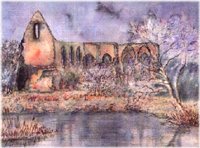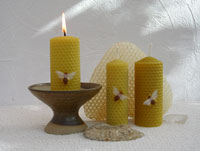Pyrford
A Brief History of an English Village
Pyrford is a village in Surrey, England not far from the
towns of Woking and Guildford on the outskirts of London.
The name Pyrford is derived from the saxon Pyrianforde which means "the
ford by the pear tree".
The area has a long history with evidence of habitation from pre-historic times. The Pyrford Stone which now stands at the corner by Upshott Lane is thought to be a pre-historic standing stone and the circular hilltop churchyard of St.Nicholas Church is indicative of an early settlement.
The Pyrford Stone, in common with many other standing stones, is reputed to move around at midnight. The Stone was originally in the centre of the road, but was moved in 1976 when the road was widened. It is said that the Pyrford Stone measures one megalithic yard. On icy mornings it is not unusual to see a car in the ditch here, (maybe the Stone plays tricks in return for the disrespectful treatment it received) - drivers take care!
Evidence has been found of Roman occupation and a pot of coins from the first century AD were discovered when Romans Way was being built.
King Eadwig granted the Saxon manor of Pyrianforde to a friend in 956AD
and a Charter exists which details the boundaries and with place names
still familiar despite the passage of over a thousand years.
To Timeline
 When William the Conqueror conducted the great Domesday
Survey, Pyrford had a population of around 100 and was valued at £18.
There was arable land for seven plough teams, half of which were owned
by the villagers themselves; fifteen acres of meadows and woods with pasture
for eighty pigs. Two mills were recorded and there may have been a chapel.
When William the Conqueror conducted the great Domesday
Survey, Pyrford had a population of around 100 and was valued at £18.
There was arable land for seven plough teams, half of which were owned
by the villagers themselves; fifteen acres of meadows and woods with pasture
for eighty pigs. Two mills were recorded and there may have been a chapel.
King William granted the "Manor of Piriford in the Forest of Windlesores" to the Abbott of Westminster in 1087. This Royal Charter carries one of very few remaining impressions of his Great Seal and is of considerable historical importance. The Charter is now kept at Westminster Abbey. The granting of the Charter was fortunate for Pyrford as the Abbey's estates became tax free! Pyrford remained under Westminster Abbey until 1539.
 The Church of St.Nicholas was built around 1140
AD and is a fine example of a complete Norman church.
The Church of St.Nicholas was built around 1140
AD and is a fine example of a complete Norman church.
 Original
frescoes painted in red ochre were uncovered during renovations in 1869
and 1967.
Original
frescoes painted in red ochre were uncovered during renovations in 1869
and 1967.
There are two sets of drawings from different periods with subjects including
scenes from Christ's Passion and an illustration of Pilgrims preparing
to set sail for a pilgrimage to Spain.
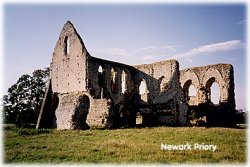 Newark Priory was founded at the end of the twelfth century
by Ruald de Clane and his wife Beatrice of Send and dedicated to the Virgin
Mary and Thomas a Beckett. It was a "novo loco" - a new place for monks
from nearby, the name changing over the years to Newstead and then finally
Newark.
Newark Priory was founded at the end of the twelfth century
by Ruald de Clane and his wife Beatrice of Send and dedicated to the Virgin
Mary and Thomas a Beckett. It was a "novo loco" - a new place for monks
from nearby, the name changing over the years to Newstead and then finally
Newark.
In the fourteenth century Pyrford was a thriving community : seventy of the one hundred and seventy tenants recorded around this period had their own smallholdings. At this time a resident of Pyrford would have received a penny a day for haymaking or twopence for stacking corn.
The Black Death, the bubonic plague, swept across England in the middle of the fourteenth century and in common with many other towns and villages, the population of Pyrford was halved.
King Henry VII Cottage, along the Pyrford Road, was built around 1500.
 King Henry VIII dissolved the monasteries
in 1539. At Newark, the prior was pensioned off, valuables sent to the
Tower of London and the land given to the Master of the Kings Horse. It
has been said that a canon was employed from the top of Church Hill to
bombard or demolish, what were, the then extensive buildings! This incident
is portrayed in one of a series of paintings made by artist Tessa Kewen
in 1963 which are displayed in the porch of St.Nicholas Church.
King Henry VIII dissolved the monasteries
in 1539. At Newark, the prior was pensioned off, valuables sent to the
Tower of London and the land given to the Master of the Kings Horse. It
has been said that a canon was employed from the top of Church Hill to
bombard or demolish, what were, the then extensive buildings! This incident
is portrayed in one of a series of paintings made by artist Tessa Kewen
in 1963 which are displayed in the porch of St.Nicholas Church.
To Timeline
The dissolution of Newark was hard on the people of Pyrford; their land was taken by the King into his hunting park which stretched for miles from Hampton Court. Local people were put under the oppressive forest laws and frequently lost their crops to his protected deer herds. Forest Law was only finally revoked at the end of the seventeenth century.
Queen Mary Tudor tried to re-establish Newark Priory but Pyrford reverted to Crown Property under Queen Elizabeth I. The Manor of Pyrford was given by her to the Earl of Lincoln, the Lord High Admiral of her Fleet. In 1550 he built himself "an house in Pyriford" - Pyrford Place. The next Lord of the Manor was Sir John Wolley. His wife, Lady Elizabeth More was a favourite Lady in Waiting to the Queen before her marriage. Elizabeth I is known to have visited Pyrford frequently and probably would have worshipped at St.Nicholas Church. She reputedly donated a silver chalice to the Church in 1570.
Sir Francis Wolley succeeded his father in 1595.
The famous poet John Donne was a friend of Sir Francis and was employed
as a secretary at Pyrford Place. Scandal ensued when the poet ran away
to marry Ann More, Francis' cousin and the heiress to Loseley near Guildford.
Her father did not approve, the poet was disgraced and sent to jail -
as was the unlucky priest who conducted the marriage. Fortunately
Sir Francis achieved a reconciliation and the Donne family lived with
him at Pyrford Place until 1610. Many of John Donne's poems were thus
written in Pyrford.
To Timeline
Lees Farm Barn (which in 1999 was converted to residential use) on Pyrford Road dates from the early seventeenth century. It has been said that it's timbers were from ships of the Spanish Armada. Lees is a version of the name Leghes, as Lees Farm was held by Roger de Leghes in 1272. The original farmhouse is The Old House next door which is much older than the barn and is said to contain secret rooms and passages. The name 'Lees' seems to have fallen into disuse after seven hundred years. The farmland is now the popular Traditions Golf course.
 Shortly after the Civil War (1642 -
1645) Sir Richard Weston initiated the project to construct the Wey Navigation
Canal. Work started in 1651 and was completed in 1653 at an eventual cost
of £16,000. The canal covered fifteen miles with twelve locks managing
a fall of sixty-eight feet. 200 men were employed on the work. The locks
including that at Pyrford were some of the earliest in England and are
now maintained by the National Trust. One can only wonder at the impact
such a huge project must have had on the lives of the local people. Initially
the Wey Navigation was not a commercial success but it later became very
profitable and the local mills shared in the prosperity. Daniel Defoe
wrote of how corn ground in mills along the banks of the Wey could be
transported economically to London for sale. It wasn't only corn that
was transported but many goods including iron, leather and gunpowder from
the Chilworth Powdermills near Guildford. Pyrford villagers were now able
to use coal which was brought in by canal for the first time.
Shortly after the Civil War (1642 -
1645) Sir Richard Weston initiated the project to construct the Wey Navigation
Canal. Work started in 1651 and was completed in 1653 at an eventual cost
of £16,000. The canal covered fifteen miles with twelve locks managing
a fall of sixty-eight feet. 200 men were employed on the work. The locks
including that at Pyrford were some of the earliest in England and are
now maintained by the National Trust. One can only wonder at the impact
such a huge project must have had on the lives of the local people. Initially
the Wey Navigation was not a commercial success but it later became very
profitable and the local mills shared in the prosperity. Daniel Defoe
wrote of how corn ground in mills along the banks of the Wey could be
transported economically to London for sale. It wasn't only corn that
was transported but many goods including iron, leather and gunpowder from
the Chilworth Powdermills near Guildford. Pyrford villagers were now able
to use coal which was brought in by canal for the first time.
To Timeline
The Parishes of Pyrford and Wisley had been joined by 1631 but the first church records are from the 1660's as earlier records had been destroyed by fire. The Parishioners of the time were it seems generous folk, amongst other donations made in 1678 were 8 shillings and threepence given towards the building of St.Pauls Cathedral, and 9 shillings and tenpence for French Protestant refugees.
In the 1750's the population of Pyrford was 133,
fewer people than before the Black Death and hardly more than at the time
of Domesday - seven centuries previously. The majority of Pyrford was
Common Land. In this period there was a local iron industry with workings
covering much of Wisley Common. Iron ore was extracted from the local
"Bagshot sand". A number of fatalities were recorded when waggons overturned
on the Common.
To Timeline
Engliff Lane takes its name from Engliff's farm. This farm covered land to the north of the junction between Boltons Lane and Engliffs Lane during the eighteenth century.
The towns were growing and their rising populations needed more food to be brought in from the countryside. Land started to be enclosed to meet this need. The Enclosure Acts at the turn of the eighteenth century brought poverty to many ordinary people who lost the common land rights which had enabled them to scrape a living from the land.
The Pyrford Act of Enclosure took place in 1815
and the Commissioners who were appointed to carry out the Acts for Pyrford
and Byfleet met at The Ship inn at Weybridge. To bring about an Act of
Enclosure required a Petition from two thirds of the owners of already
enclosed land. The Act removed common land rights and divided the land
up, the main beneficiaries being those wealthy enough to have owned land
previously.
To Timeline
In Pyrford, one thousand four hundred acres were enclosed, half of which went to the Lord of the Manor, Lord King. Some of this land, about one sixteenth, would have been given to him for nothing, the remainder was paid for at around £6 an acre.
 The new owners altered roads to suit the new boundaries and
often gave their names to them; Bolton's Lane and Tegg's Lane are examples.
Bolton's Lane used to be called Bluegate Lane. Coldharbour Road was once
called Bolton's Lane, but it seems nobody knows when or why it was changed.
The new owners altered roads to suit the new boundaries and
often gave their names to them; Bolton's Lane and Tegg's Lane are examples.
Bolton's Lane used to be called Bluegate Lane. Coldharbour Road was once
called Bolton's Lane, but it seems nobody knows when or why it was changed.
Lovelace Drive (built in the 1950's) takes its' name from the title chosen by the Eighth Lord of the Manor, the county's largest landowner, who became the 1st Earl of Lovelace in 1838. His wife was Ada Byron, Countess of Lovelace, daughter of the poet Lord Byron. Countess Lovelace was the world's first computer programmer who devised in 1843 a plan of instructions, a program, for Mr. Babbage's famous Difference Engine.
In 1834 the population of Pyrford was 320. Twenty or so people would have been destitute at any one time and their welfare was a Parish responsibility. Glebe Cottage on Pyrford Road was once the village workhouse.
The land between Pyrford Place and Henry VII Cottage on the Pyrford Road was known as Pyrford Green. Although it had been common land for centuries it was lost to the people during the Enclosures. This land continued to serve as a village green however for many years after and is where the Pyrford Cricket Club originally played until the current site was provided alongside Coldharbour Road. Today the old green is part of a golf course.
Pyrford Common is all that remains of the mediaeval Common Land. In
2007, Pyrford Common was purchased by the Horsell Common Preservation
Society. Today, if you walk quietly, you may see the Roe deer in the woods.
To Timeline
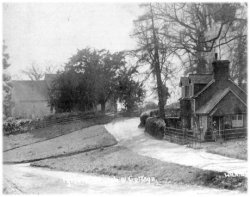 With the growth of urban development came change and a growth
in the population. A school was opened for the first time in 1846, next
to St Nicholas Church. An old postcard from around this period (illustrated
left) pre-dates the building of the Dame School and shows a cottage next
to the Church. The lady standing by the door, wearing a tall hat
is probably the school mistress. Marion Mortlock was Mistress at the school and was also the local District Nurse. She lived at one time in Providence Place and is buried in Pyrford Churchyard.
With the growth of urban development came change and a growth
in the population. A school was opened for the first time in 1846, next
to St Nicholas Church. An old postcard from around this period (illustrated
left) pre-dates the building of the Dame School and shows a cottage next
to the Church. The lady standing by the door, wearing a tall hat
is probably the school mistress. Marion Mortlock was Mistress at the school and was also the local District Nurse. She lived at one time in Providence Place and is buried in Pyrford Churchyard.
In 1851 nearly 200 of the population of 350 were agricultural workers, but by 1871 only 95 out of 450 earned their living this way. Floyd's Lane takes its name from the village baker of around this time, a Mr.Floyd.
Pyrford Cricket Club was founded in 1858.
In 1898, the famous author H G Wells put Pyrford under alien attack from the Martians!
"In another moment the colossal mechanism went striding by me, and passed uphill towards Pyrford. Seen nearer, the Thing was incredibly strange, for it was no mere insensate machine driving on its way. Machine it was, with a ringing metallic pace, and long, flexible, glittering tentacles (one of which gripped a young pine tree) swinging and rattling about its strange body. It picked its road as it went striding along, and the brazen hood that surmounted it moved to and fro with the inevitable suggestion of a head looking about. Behind the main body was a huge mass of white metal like a gigantic fisherman's basket, and puffs of green smoke squirted out from the joints of the limbs as the monster swept by me. And in an instant it was gone."
Sir Charles Wentworth Dilke (1843-1911), a well known Liberal politician of his day, bought a small house in Pyrford for a winter retreat. He called it The Rough. Sir Charles was Under Secretary for Foreign Affairs and later President of the Local Government Board in Prime Minister Gladstone's Cabinet. He was chairman of the Committee which brought about the major reforms of the Local Government Act in 1888. Dilke, a radical left-winger was a republican who sympathised with the trade union movement and was involved with the beginnings of the British Labour Party.
The Royal Horticultural Society moved to Wisley in 1904, the Garden is now famous worldwide and thousands visit it's wonderful gardens every year.
The Waifs and Strays Society moved to Pyrford at the same period and
eventually St. Nicholas and St. Martin's Homes were built to house disabled
children. These homes developed into The Rowley Bristow Hospital named
after a well known orthopaedic surgeon. In its' time the Rowley Bristow
Hospital was considered a centre of excellence.
To Timeline
Pyrford Village Hall was built in 1921 to commemorate the people of Pyrford who died during the Great War (1914-1918)
During the Second World War (1939-1945), the 20th Guard Brigade used Pyrford Court as accomodation for their HQ staff after Dunkirk. The house was also used by troop entertainment concert parties. In November 1940, King George VI dined at Pyrford Court whilst visiting the Guards.
Royal Air Force Pilot, Lorne Welch, (Patrick Palles Lorne Ephinstone Welch.) was the son of Mrs Welch (nee Elphinstone) of Pyrford Mill. Lorne Welch played a role in two of the most well known escapes by Allied prisoners during World War II, being responsible for the tunnel ventilation system famously depicted in "The Great Escape". He was also a prisoner in Colditz.
 In
1947 the first annual Pyrford and Wisley Flower Show was held.
In
1947 the first annual Pyrford and Wisley Flower Show was held.
The Flower Show which has become a very popular and well attended event
is held on the Cricket Green, at the beginning of July. The wonderful
floral displays by the various Flower Clubs are particularly beautiful.
Money is raised for many local charities.
In the 1950's Pyrford Woods were felled for the construction of residential
Pyrford and the population expanded to over 5,000. The writer Sylvia Lewin
recalls the district shortly before this as "a paradise for naturalists...nightingales
in the copses, red squirrels in the woods...glow worms and snakes.. and
countless frogs by the pond on the green".
With the large increase in population came the need for new facilities.
Pyrford Church of England Primary School on Coldharbour Road was built
at this time. Originally there were two separate schools on the site but
these were later merged into one unit.
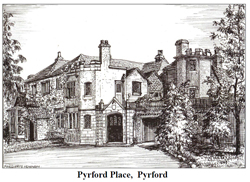
The artist Marguerite Howarth (1908-2008) a member of the Society of Women Artists moved to Woodham at the outbreak of World War 2. Mrs Howarth produced a number of pen and ink drawings, including fine drawings of Pyrford, in the late 1950's. A series of these and a calendar were published by the Woking Review. This picture shows Pyrford Place as it stood in the 1950's, the original building being knocked down and replaced in the 1980's.
The foundation stone for the Church of the Good Shepherd was laid on
1st June 1963 and dedicated by the Bishop of Guildford the following year.
To Timeline
In the early 1980's the old stables at Pyrford Court, on the Pyrford Road, were used as a location in the cult horror film "The Omen". Residents of what is now called The Bothy will recognise their imposing gateway, which was used as the entrance to the home of the American Ambassador in the film.
When the Rowley Bristow Hospital became redundant at the end of the 1980's, the area was derelict for several years. During this time the hospital grounds were used as a "Paint-Ball" (war-game) activity centre. Eventually, the site was re-developed as the St.Nicholas Crescent and St.Martins Mews residential estate and the woods were quiet again.
The Byfleet Lawn Tennis Club moved to Pyrford, to a new site behind the Health Club along the Pyrford Road, in 1994.. The Club is now over 100 years old and was previously based in Dartnell Avenue, West Byfleet.
The "Information Super-Highway", the internet, reached Pyrford at the
start of the 1990's. The first Pyrford web-site was set up by Pyrford Press in 1994.
Pyrford residents discovered a liking for fireworks on Millenium Eve, everyone gathered outside to watch the displays and to see the passing of the 20th Century. Many bottles of champagne were enjoyed on street corners!
In 2004
Pyrford's reknowned healer Mr.Jack Temple passed away. Mr Temple's legendary knowledge
and skills were sought by many including Diana, Princess of Wales and
The Duchess of York.

Jack's Ring of Stones still stands alongside the
Pyrford Road, next to the children's nursery, now known as the Spirit Day Care Centre. Pyrford is unusual in having a modern stone circle as well as an ancient Standing Stone
 Her Majesty the Queen's Golden Jubilee in 2012 was celebrated with enthusiasm in Pyrford on 4th June 2012 and a number of street parties were held. In Lincoln Drive there was a large party with fun and games for children and grown ups. Activities included races for the children, a decorated wheely bin contest, a knobbly knees competition for the gentlemen, a release of racing pigeons and community singing of patriotic songs. There was tea, of course, and a large selection of cakes, plus a hog roast. The Mayor and Lady Mayoress of Woking attended and presented prizes and medals.
Her Majesty the Queen's Golden Jubilee in 2012 was celebrated with enthusiasm in Pyrford on 4th June 2012 and a number of street parties were held. In Lincoln Drive there was a large party with fun and games for children and grown ups. Activities included races for the children, a decorated wheely bin contest, a knobbly knees competition for the gentlemen, a release of racing pigeons and community singing of patriotic songs. There was tea, of course, and a large selection of cakes, plus a hog roast. The Mayor and Lady Mayoress of Woking attended and presented prizes and medals.
There was more excitement in Pyrford in 2012 when the Olympic Cycle Road Races came through the village.
The photograph shows the Men's race as the riders came along Upshott Lane towards the Pyrford Stone.
History is being made around us all the time and we live in a period of exciting technological change. But not all change is progress, things valued or taken for granted today may well be gone tomorrow. Our open spaces, clean air and wildlife are under threat and need our care if Pyrford is to remain a pleasant place to live.
There is an old farming
saying :
"Love your family and live each day as if it
were your last,
but care for the land as though you were to live a thousand years"
- so care for Pyrford, even though you may only live here for a little
while.
|
References and other information
|
We have heard from people all over the world with connections to Pyrford. Thank you all for your interest.
Copyright(s) of authors and artists referenced on this page is acknowledged
Copyright © Pyrford Press 2000-2013.
Page last updated May 2013
Where Next?
